Garlic
Garlic (Allium sativum) is a species in the onion genus, Allium. Its close relatives include the onion, shallot, leek, chive,[2] and Chinese onion.[3] It is native to Central Asia and northeastern Iran, and has long been a common seasoning worldwide, with a history of several thousand years of human consumption and use.[4][5] It was known to ancient Egyptians, and has been used both as a food flavoring and as a traditional medicine.[6][7] China produces some 80% of the world's supply of garlic.[8][9]
| Garlic | |
|---|---|
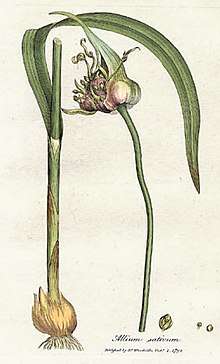 | |
| Allium sativum, known as garlic, from William Woodville, Medical Botany, 1793. | |
| Scientific classification | |
| Kingdom: | Plantae |
| Clade: | Tracheophytes |
| Clade: | Angiosperms |
| Clade: | Monocots |
| Order: | Asparagales |
| Family: | Amaryllidaceae |
| Subfamily: | Allioideae |
| Genus: | Allium |
| Species: | A. sativum |
| Binomial name | |
| Allium sativum | |
| Synonyms | |
|
Synonymy
| |
Etymology
The word garlic derives from Old English, garlēac, meaning gar (spear) and leek, as a 'spear-shaped leek'.[10]
Description
Allium sativum is a perennial flowering plant growing from a bulb, it has a tall, erect flowering stem that grows up to 1 m (3 ft). The leaf blade is flat, linear, solid, and approximately 1.25–2.5 cm (0.5–1.0 in) wide, with an acute apex. The plant may produce pink to purple flowers from July to September in the Northern Hemisphere. The bulb is odiferous and contains outer layers of thin sheathing leaves surrounding an inner sheath that encloses the clove. Often the bulb contains 10 to 20 cloves that are asymmetric in shape, except for those closest to the center.[6] If garlic is planted at the proper time and depth, it can be grown as far north as Alaska.[11] It produces hermaphrodite flowers. It is pollinated by bees, butterflies, moths, and other insects.[12]
Origin and major types
Identification of the wild progenitor of common garlic is difficult due to the sterility of its many cultivars, which limits the ability to cross test with wild relatives. Genetically and morphologically, garlic is most similar to the wild species Allium longicuspis, which grows in central and southwestern Asia.[13][14][15] However, because Allium longicuspis is also mostly sterile, it is doubtful that it is the ancestor of Allium sativum.[13] Other candidates that have been suggested include Allium tuncelianum, Allium macrochaetum, and Allium truncatum, all of which are native to the Middle East.[13]
Allium sativum grows in the wild in areas where it has become naturalized. The "wild garlic", "crow garlic", and "field garlic" of Britain are members of the species Allium ursinum, Allium vineale, and Allium oleraceum, respectively. In North America, Allium vineale (known as "wild garlic" or "crow garlic") and Allium canadense, known as "meadow garlic", "wild garlic", or "wild onion", are common weeds in fields.[16] So-called elephant garlic is actually a wild leek (Allium ampeloprasum), and not a true garlic. Single clove garlic (also called pearl or solo garlic) originated in the Yunnan province of China.
European garlic
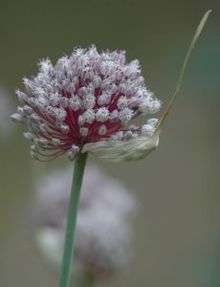
Some garlics have protected status in Europe[17], including:
| Name | Source |
|---|---|
| Aglio Rosso di Nubia (Red Garlic of Nubia) | Nubia-Paceco, Provincia di Trapani, Sicily, Italy |
| Aglio Bianco Polesano | Rovigo, Veneto, Italy (PDO) |
| Aglio di Voghiera | Ferrara, Emilia-Romagna, Italy (PDO) |
| Ail blanc de Lomagne | Lomagne in the Gascony, France (PGI) |
| Ail de la Drôme | Drôme, France (PGI) |
| Ail rose de Lautrec, a rose/pink garlic | Lautrec, France (PGI) |
| Ail violet de Cadours | Cadours, France (PDO) |
| Ajo Morado de Las Pedroñeras, a rose/pink garlic | Las Pedroñeras, Spain (PGI) |
| 金乡大蒜 Jinxiang Da Suan | China (PGI) |
Subspecies and varieties
There are two subspecies of A. sativum,[18] ten major groups of varieties, and hundreds of varieties or cultivars.
- A. sativum var. ophioscorodon (Link) Döll, called Ophioscorodon, or hard-necked garlic, includes porcelain garlics, rocambole garlic, and purple stripe garlics. It is sometimes considered to be a separate species, Allium ophioscorodon G.Don.
- A. sativum var. sativum, or soft-necked garlic, includes artichoke garlic, silverskin garlic, and creole garlic.
There are at least 120 cultivars originating from Central Asia, making it the main center of garlic biodiversity.[19]
Cultivation
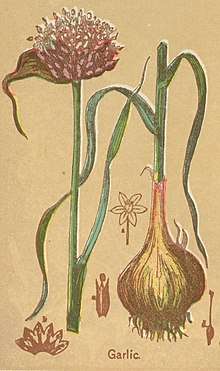
Garlic is easy to grow and can be grown year-round in mild climates.[20] While sexual propagation of garlic is possible, nearly all of the garlic in cultivation is propagated asexually, by planting individual cloves in the ground.[14] In colder climates, cloves are best planted about six weeks before the soil freezes. The goal is to only have the bulbs produce roots and no shoots above the ground.[21] Harvest is in late spring or early summer.
Garlic plants can be grown closely together, leaving enough space for the bulbs to mature, and are easily grown in containers of sufficient depth. Garlic does well in loose, dry, well-drained soils in sunny locations, and is hardy throughout USDA climate zones 4–9. When selecting garlic for planting, it is important to pick large bulbs from which to separate cloves. Large cloves, along with proper spacing in the planting bed, will also increase bulb size. Garlic plants prefer to grow in a soil with a high organic material content, but are capable of growing in a wide range of soil conditions and pH levels.[14]
There are different varieties or subspecies of garlic, most notably hardneck garlic and softneck garlic.[20] The latitude where the garlic is grown affects the choice of type, as garlic can be day-length sensitive. Hardneck garlic is generally grown in cooler climates and produces relatively large cloves, whereas softneck garlic is generally grown closer to the equator and produces small, tightly-packed cloves.[20]
Garlic scapes are removed to focus all the garlic's energy into bulb growth. The scapes can be eaten raw or cooked.[22][23]
Diseases
Garlic plants are usually hardy and not affected by many pests or diseases. Garlic plants are said to repel rabbits and moles.[3] The California Department of Food and Agriculture (CDFA) conducts a certification program to assure freedom from nematode and white rot disease caused by Stromatinia cepivora, two pathogens that can both destroy a crop as well as remain in the soil indefinitely, once introduced.[14] Garlic may also suffer from pink root, a typically non-fatal disease that stunts the roots and turns them pink or red;[24] or leek rust.[20] The larvae of the leek moth attack garlic by mining into the leaves or bulbs.[25]
Production
| Country | Production (millions of tonnes) |
|---|---|
| 22.2 | |
| 1.7 | |
| 0.4 | |
| 0.3 | |
| 0.3 | |
| 0.3 | |
| World | 28.2 |
| May include official, semi-official or estimated data Source: UN Food and Agriculture Organization[8] | |
In 2017, world production of garlic was 28.2 million tonnes, with China alone accounting for 79% of the total (table).[8]
The United States grows less than 1% of China's production.[8] Much of the garlic production in the United States is centered in Gilroy, California, which calls itself the "Garlic Capital of the World".[26]
Properties
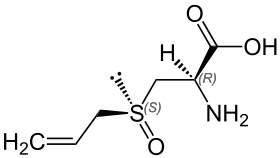
Fresh or crushed garlic yields the sulfur-containing compounds alliin, ajoene, diallyl polysulfides, vinyldithiins, S-allylcysteine, and enzymes, saponins, flavonoids, and Maillard reaction products, which are not sulfur-containing compounds.
The phytochemicals responsible for the sharp flavor of garlic are produced when the plant's cells are damaged. When a cell is broken by chopping, chewing, or crushing, enzymes stored in cell vacuoles trigger the breakdown of several sulfur-containing compounds stored in the cell fluids (cytosol). The resultant compounds are responsible for the sharp or hot taste and strong smell of garlic. Some of the compounds are unstable and continue to react over time. Among the members of the onion family, garlic has by far the highest concentrations of initial reaction products, making garlic much more potent than onion, shallot, or leeks.[27] Although many humans enjoy the taste of garlic, these compounds are believed to have evolved as a defensive mechanism, deterring animals such as birds, insects, and worms from eating the plant.[28] Because of this, people throughout history have used garlic to keep away insects such as mosquitoes and slugs.
A large number of sulfur compounds contribute to the smell and taste of garlic. Allicin has been found to be the compound most responsible for the "hot" sensation of raw garlic. This chemical opens thermo-transient receptor potential channels that are responsible for the burning sense of heat in foods. The process of cooking garlic removes allicin, thus mellowing its spiciness.[28] Allicin, along with its decomposition products diallyl disulfide and diallyl trisulfide, are major contributors to the characteristic odor of garlic, with other allicin-derived compounds, such as vinyldithiins and ajoene.[2] Because of its strong odor, garlic is sometimes called the "stinking rose". When eaten in quantity, garlic may be strongly evident in the diner's sweat and garlic breath the following day. This is because garlic's strong-smelling sulfur compounds are metabolized, forming allyl methyl sulfide. Allyl methyl sulfide (AMS) cannot be digested and is passed into the blood. It is carried to the lungs and the skin, where it is excreted. Since digestion takes several hours, and release of AMS several hours more, the effect of eating garlic may be present for a long time.[2]
The well-known phenomenon of "garlic breath" is allegedly alleviated by eating fresh parsley.[29] The herb is, therefore, included in many garlic recipes, such as pistou, persillade, and the garlic butter spread used in garlic bread.
Because of the AMS in the bloodstream, it is believed by some to act as a mosquito repellent, but no clinically reported evidence suggests it is actually effective.[30]
Abundant sulfur compounds in garlic are also responsible for turning garlic green or blue during pickling and cooking. Under these conditions (i.e. acidity, heat) the sulfur-containing compound alliin reacts with common amino acids to make pyrroles, clusters of carbon-nitrogen rings.[31][32] These rings can be linked together into polypyrrole molecules. Ring structures absorb particular wavelengths of light and thus appear colored. The two-pyrrole molecule looks red, the three-pyrrole molecule looks blue, and the four-pyrrole molecule looks green (like chlorophyll, a tetrapyrrole). Like chlorophyll, the pyrrole pigments are safe to eat.[33]
Upon cutting, similar to a color change in onion caused by reactions of amino acids with sulfur compounds,[34] garlic can turn green.[35][36]
History
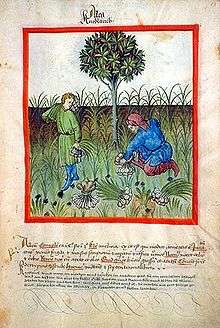
Culinary
Numerous cuneiform records show that garlic has been cultivated in Mesopotamia for at least 4,000 years.[13] The use of garlic in China and Egypt also dates back thousands of years.[2][13] Well preserved garlic was found in the tomb of Tutankhamun (c. 1325 BC).[13] It was consumed by ancient Greek and Roman soldiers, sailors, and rural classes (Virgil, Eclogues ii. 11), and, according to Pliny the Elder (Natural History xix. 32), by the African peasantry. Garlic was placed by the ancient Greeks on the piles of stones at crossroads, as a supper for Hecate (Theophrastus, Characters, The Superstitious Man).
Garlic was rare in traditional English cuisine (though it is said to have been grown in England before 1548), but has been a common ingredient in Mediterranean Europe.[37] Translations of the c. 1300 Assize of Weights and Measures, an English statute generally dated to the 13th century, indicate a passage as dealing with standardized units of garlic production, sale, and taxation — the hundred of 15 ropes of 15 heads each[38] – but the Latin version of the text may refer to herring rather than garlic.[39]
Medicinal
In his Natural History, Pliny gives a list of scenarios in which garlic was considered beneficial (N.H. xx. 23). Galen, writing in the second century, eulogized Garlic as the "rustic's theriac" (cure-all) (see F. Adams' Paulus Aegineta, p. 99). Avicenna, in The Canon of Medicine (1025), recommends garlic for the treatment of a wide variety of ailments including arthritis, snake and insect bites, parasites, chronic cough, and as antibiotic for infectious diseases.[40] Alexander Neckam, a writer of the 12th century (see Wright's edition of his works, p. 473, 1863), discussed it as a palliative for the heat of the sun in field labor. In the 17th century, Thomas Sydenham valued it as an application in confluent smallpox, and William Cullen's Materia Medica of 1789 found some dropsies cured by it alone.[41] Garlic was used as an antiseptic to prevent gangrene during World War I and World War II.[42]
Uses
Culinary
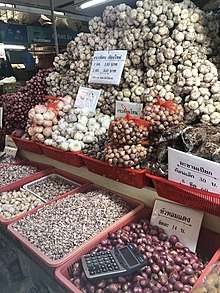
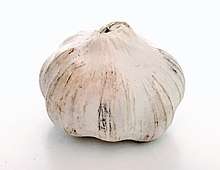
Garlic is widely used around the world for its pungent flavor as a seasoning or condiment.
The garlic plant's bulb is the most commonly used part of the plant. With the exception of the single clove types, garlic bulbs are normally divided into numerous fleshy sections called cloves. Garlic cloves are used for consumption (raw or cooked) or for medicinal purposes. They have a characteristic pungent, spicy flavor that mellows and sweetens considerably with cooking.[43] The distinctive aroma is mainly due to organosulfur compounds including allicin present in fresh garlic cloves and ajoene which forms when they are crushed or chopped. A further metabolite allyl methyl sulfide is responsible for garlic breath. [44][45] [46] [47]
Other parts of the garlic plant are also edible. The leaves and flowers (bulbils) on the head (spathe) are sometimes eaten. They are milder in flavor than the bulbs,[3] and are most often consumed while immature and still tender. Immature garlic is sometimes pulled, rather like a scallion, and sold as "green garlic".[48] When green garlic is allowed to grow past the "scallion" stage, but not permitted to fully mature, it may produce a garlic "round", a bulb like a boiling onion, but not separated into cloves like a mature bulb.[49] It imparts a garlic flavor and aroma in food, minus the spiciness. Green garlic is often chopped and stir-fried or cooked in soup or hot pot in Southeast Asian (i.e. Vietnamese, Thai, Myanmar, Lao, Cambodian, Singaporean), and Chinese cookery, and is very abundant and low-priced. Additionally, the immature flower stalks (scapes) of the hardneck and elephant types are sometimes marketed for uses similar to asparagus in stir-fries.[14]
Inedible or rarely eaten parts of the garlic plant include the "skin" covering each clove and root cluster. The papery, protective layers of "skin" over various parts of the plant are generally discarded during preparation for most culinary uses, though in Korea immature whole heads are sometimes prepared with the tender skins intact.[50] The root cluster attached to the basal plate of the bulb is the only part not typically considered palatable in any form. An alternative is to cut the top off the bulb, coat the cloves by dribbling olive oil (or other oil-based seasoning) over them, and roast them in an oven. Garlic softens and can be extracted from the cloves by squeezing the (root) end of the bulb, or individually by squeezing one end of the clove. In Korea, heads of garlic are heated over the course of several weeks; the resulting product, called black garlic, is sweet and syrupy, and is exported to the United States, United Kingdom, and Australia.
Garlic may be applied to different kinds of bread, usually in a medium of butter or oil, to create a variety of classic dishes, such as garlic bread, garlic toast, bruschetta, crostini, and canapé. The flavor varies in intensity and aroma with the different cooking methods. It is often paired with onion, tomato, or ginger.
Immature scapes are tender and edible. They are also known as "garlic spears", "stems", or "tops". Scapes generally have a milder taste than the cloves. They are often used in stir frying or braised like asparagus.[23] Garlic leaves are a popular vegetable in many parts of Asia. The leaves are cut, cleaned, and then stir-fried with eggs, meat, or vegetables.
Garlic powder has a different taste from fresh garlic. If used as a substitute for fresh garlic, 1/8 teaspoon of garlic powder is approximate to one clove of garlic.
Regions
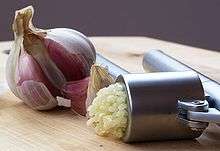
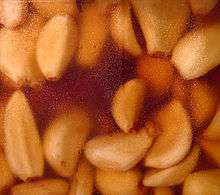
Garlic is a fundamental component in many or most dishes of various regions, including eastern Asia, South Asia, Southeast Asia, the Middle East, northern Africa, southern Europe, and parts of Latin America. Latin American seasonings, particularly, use garlic in sofritos and mofongos.[52]
Oils can be flavored with garlic cloves. These infused oils are used to season all categories of vegetables, meats, breads, and pasta. Garlic, along with fish sauce, chopped fresh chilis, lime juice, sugar, and water, is a basic essential item in dipping fish sauce, a highly used dipping sauce condiment used in Indochina. In East and Southeast Asia, chili oil with garlic is a popular dipping sauce, especially for meat and seafood. Tuong ot toi Viet Nam (Vietnam chili garlic sauce) is a highly popular condiment and dip across North America and Asia.
In some cuisines, the young bulbs are pickled for three to six weeks in a mixture of sugar, salt, and spices. In eastern Europe, the shoots are pickled and eaten as an appetizer. Laba garlic, prepared by soaking garlic in vinegar, is a type of pickled garlic served with dumplings in northern China to celebrate the Chinese New Year.[2]
Garlic is essential in Middle Eastern and Arabic cooking, with its presence in many food items. In Levantine countries such as Jordan, Palestine, and Lebanon, garlic is traditionally crushed together with olive oil, and occasionally salt, to create a Middle Eastern garlic sauce called Toum (تُوم; meaning "garlic" in Arabic). While not exclusively served with meats, toum is commonly paired with chicken or other meat dishes such as shawarma. Garlic is also a key component in some hummus varieties, an Arabic dip composed of chickpeas, tahini, garlic, lemon juice, and salt.
Lightly smoked garlic is used in British and other European cuisine. It is particularly prized for stuffing poultry and game, and in soups and stews.
Emulsifying garlic with olive oil produces aioli. Garlic, oil, and a chunky base produce skordalia. Blending garlic, almond, oil, and soaked bread produces ajoblanco. Tzatziki, yogurt mixed with garlic and salt, is a common sauce in Eastern Mediterranean cuisines.
Storage
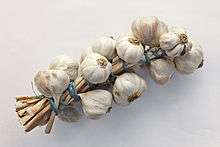
Domestically, garlic is stored warm [above 18 °C (64 °F)] and dry to keep it dormant (to inhibit sprouting). It is traditionally hung; softneck varieties are often braided in strands called plaits or grappes. Peeled cloves may be stored in wine or vinegar in the refrigerator.[53] Commercially, garlic is stored at 0 °C (32 °F), in a dry, low-humidity environment. Garlic will keep longer if the tops remain attached.[14]
Garlic is often kept in oil to produce flavored oil; however, the practice requires measures to be taken to prevent the garlic from spoiling which may include rancidity and growth of Clostridium botulinum.[54] Acidification with a mild solution of vinegar minimizes bacterial growth.[54] Refrigeration does not assure the safety of garlic kept in oil, requiring use within one month to avoid bacterial spoilage.[54] Garlic is also dried at low temperatures, to preserve the enzymatic activity and sold and kept as garlic granules, and can be rehydrated to reactivate it.[55]
Stored garlic can be affected by Penicillium decay known as blue mold (or green mold in some locales), especially in high humidity.[56] Infection may first appear as soft or water-soaked spots, followed by white patches (of mycelium) which turn blue or green with sporulation.[57] As sporulation and germination are delayed at low temperature, and at -4 deg. C are inhibited entirely,[58], in refrigerated cloves one may only see the white mycellium during early stages. Penicillium hirsutum[59] and Penicillium allii[60] are two of the predominant species identified in blue mold.
Medical research
Cardiovascular
As of 2015, clinical research to determine the effects of consuming garlic on hypertension found that consuming garlic produces only a small reduction in blood pressure (4 mmHg),[61][62][63] and there is no clear long-term effect on cardiovascular morbidity and mortality.[63] A 2016 meta-analysis indicated there was no effect of garlic consumption on blood levels of lipoprotein(a), a biomarker of atherosclerosis.[64] Because garlic might reduce platelet aggregation, people taking anticoagulant medication are cautioned about consuming garlic.[7][65][66]
Cancer
A 2016 meta-analysis of case-control and cohort studies found a moderate inverse association between garlic intake and some cancers of the upper digestive tract.[67] Another meta-analysis found decreased rates of stomach cancer associated with garlic intake, but cited confounding factors as limitations for interpreting these studies.[68] Further meta-analyses found similar results on the incidence of stomach cancer by consuming allium vegetables including garlic.[69][70] A 2014 meta-analysis of observational epidemiological studies found that garlic consumption was associated with a lower risk of stomach cancer in Korean people.[71]
A 2016 meta-analysis found no effect of garlic on colorectal cancer.[72] A 2014 meta-analysis found garlic supplements or allium vegetables to have no effect on colorectal cancers.[73]
A 2013 meta-analysis of case-control and cohort studies found limited evidence for an association between higher garlic consumption and reduced risk of prostate cancer, but the studies were suspected as having publication bias.[74] A 2013 meta-analysis of epidemiological studies found garlic intake to be associated with decreased risk of prostate cancer.[74]
Common cold
A 2014 Cochrane review[75] found insufficient evidence to determine the effects of garlic in preventing or treating the common cold.[75] Other reviews concluded a similar absence of high-quality evidence for garlic having a significant effect on the common cold.[7][76]
Other uses
The sticky juice within the bulb cloves is used as an adhesive in mending glass and porcelain.[3] An environmentally benign garlic-derived polysulfide product is approved for use in the European Union (under Annex 1 of 91/414) and the UK as a nematicide and insecticide, including for use for control of cabbage root fly and red mite in poultry.[77]
Adverse effects and toxicology
Garlic is known to cause bad breath (halitosis) and body odor, described as a pungent "garlicky" smell to sweat.[6] This is caused by allyl methyl sulfide (AMS). AMS is a volatile liquid which is absorbed into the blood during the metabolism of garlic-derived sulfur compounds; from the blood it travels to the lungs[2] (and from there to the mouth, causing bad breath; see garlic breath) and skin, where it is exuded through skin pores. Washing the skin with soap is only a partial and imperfect solution to the smell. Studies have shown sipping milk at the same time as consuming garlic can significantly neutralize bad breath.[78] Mixing garlic with milk in the mouth before swallowing reduced the odor better than drinking milk afterward.[78] Plain water, mushrooms, and basil may also reduce the odor; the mix of fat and water found in milk, however, was the most effective.[78]
The green, dry "folds" in the center of the garlic clove are especially pungent. The sulfur compound allicin, produced by crushing or chewing fresh garlic,[6] produces other sulfur compounds: ajoene, allyl polysulfides, and vinyldithiins.[2] Aged garlic lacks allicin, but may have some activity due to the presence of S-allylcysteine.
Some people suffer from allergies to garlic and other species of Allium.[2] Symptoms can include irritable bowel, diarrhea, mouth and throat ulcerations, nausea, breathing difficulties, and, in rare cases, anaphylaxis.[6] Garlic-sensitive people show positive tests to diallyl disulfide, allylpropyldisulfide, allylmercaptan, and allicin, all of which are present in garlic. People who suffer from garlic allergies are often sensitive to many other plants, including onions, chives, leeks, shallots, garden lilies, ginger, and bananas.
Several reports of serious burns resulting from garlic being applied topically for various purposes, including naturopathic uses and acne treatment, indicate care must be taken for these uses, usually testing a small area of skin using a low concentration of garlic.[79] On the basis of numerous reports of such burns, including burns to children, topical use of raw garlic, as well as insertion of raw garlic into body cavities, is discouraged.[6] In particular, topical application of raw garlic to young children is not advisable.[80]
The side effects of long-term garlic supplementation are largely unknown.[6] Possible side effects include gastrointestinal discomfort, sweating, dizziness, allergic reactions, bleeding, and menstrual irregularities.[7]
Some breastfeeding mothers have found, after consuming garlic, that their babies can be slow to feed, and have noted a garlic odor coming from them.[6][81]
If higher-than-recommended doses of garlic are taken with anticoagulant medications, this can lead to a higher risk of bleeding.[6][82] Garlic may interact with warfarin,[6] saquinavir, antihypertensives, calcium channel blockers, the quinolone family of antibiotics such as ciprofloxacin, and hypoglycemic drugs, as well as other medications.[81] Alliums might be toxic to cats or dogs.[83]
Spiritual and religious uses
In folklore, garlic has been regarded as a force for both good and evil. In Europe, many cultures have used garlic for protection or white magic, perhaps owing to its reputation in folk medicine.[7] Central European folk beliefs considered garlic a powerful ward against demons, werewolves, and vampires. To ward off vampires, garlic could be worn, hung in windows, or rubbed on chimneys and keyholes.[84][85]
In the foundation myth of the ancient Korean kingdom of Gojoseon, eating nothing but 20 cloves of garlic and a bundle of Korean mugwort for 100 days let a bear be transformed into a woman.[86]
In celebration of Nowruz (Persian calendar New Year), garlic is one of the essential items in a Haft-sin (= "Seven things beginning with 'S' ") table, a traditional New Year's display: the name for garlic in Farsi is سیر (seer), which begins with "س" (sin, pronounced "seen") the Perso-Arabic letter corresponding to "S".
In Islam, it is recommended not to eat raw garlic prior to going to the mosque. This is based on several hadith.[87][88]
Nutrition
| Nutritional value per 100 g (3.5 oz) | |
|---|---|
| Energy | 623 kJ (149 kcal) |
33.06 g | |
| Sugars | 1 g |
| Dietary fiber | 2.1 g |
0.5 g | |
6.36 g | |
| Vitamins | Quantity %DV† |
| Thiamine (B1) | 17% 0.2 mg |
| Riboflavin (B2) | 9% 0.11 mg |
| Niacin (B3) | 5% 0.7 mg |
| Pantothenic acid (B5) | 12% 0.596 mg |
| Vitamin B6 | 95% 1.2350 mg |
| Folate (B9) | 1% 3 μg |
| Choline | 5% 23.2 mg |
| Vitamin C | 38% 31.2 mg |
| Minerals | Quantity %DV† |
| Calcium | 18% 181 mg |
| Iron | 13% 1.7 mg |
| Magnesium | 7% 25 mg |
| Manganese | 80% 1.672 mg |
| Phosphorus | 22% 153 mg |
| Potassium | 9% 401 mg |
| Sodium | 1% 17 mg |
| Zinc | 12% 1.16 mg |
| Other constituents | Quantity |
| Water | 59 g |
| selenium | 14.2 μg |
| |
| †Percentages are roughly approximated using US recommendations for adults. Source: USDA Nutrient Database | |
In the typical serving size of 1–3 cloves (3–9 grams), garlic provides no significant nutritional value, with the content of all essential nutrients below 10% of the Daily Value (DV) (table).[89] When expressed per 100 grams, garlic contains several nutrients in rich amounts (20% or more of the DV), including vitamins B6 and C, and the dietary minerals manganese and phosphorus. Per 100 gram serving, garlic is also a moderate source (10–19% DV) of certain B vitamins, including thiamin and pantothenic acid, as well as the dietary minerals calcium, iron, and zinc (table).
The composition of raw garlic is 59% water, 33% carbohydrates, 6% protein, 2% dietary fiber, and less than 1% fat.[89]
Gallery
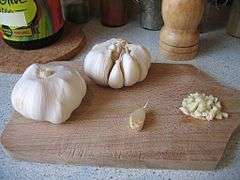 Chopped garlic
Chopped garlic- Garlic plant
- Freshly harvested garlic
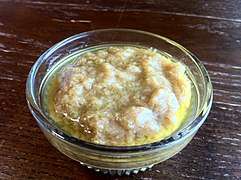 Blended garlic confit
Blended garlic confit
See also
- Garlic festivals
- Garlic Is as Good as Ten Mothers. Directed by Les Blank.
- Garlic oil
- Garlic powder
- Garlic salt
- Garlic sauce
- Herbalism
- International Code of Nomenclature for Cultivated Plants
- List of garlic dishes
- Pyruvate scale
References
- "Allium sativum L". Kewscience; Plants of the World Online; Royal Botanic Gardens, Kew, England. Retrieved May 26, 2017.
- Block, Eric (2010). Garlic and Other Alliums: The Lore and the Science. Royal Society of Chemistry. ISBN 978-0-85404-190-9.
- "Substance Info: Garlic". All Allergy. Zing Solutions. Archived from the original on June 15, 2010. Retrieved April 14, 2010.
- "Allium sativum L." Plants of the World Online | Kew Science. Retrieved October 31, 2018.
- Block, Eric (2010). Garlic and Other Alliums: The Lore and the Science. Royal Society of Chemistry. pp. 5–6. ISBN 9780854041909.
- "Garlic". Drugs.com. August 20, 2018. Retrieved October 31, 2018.
- "Garlic". National Center for Complementary and Integrative Health, US National Institutes of Health. April 2012. Retrieved May 4, 2016.
- "Garlic production in 2017: Crops/World Regions/Production Quantity (from pick lists)". Food and Agriculture Organization of the United Nations, Statistics Division (FAOSTAT). 2019. Retrieved December 20, 2019.
- "2018 Will be the Most Difficult Year for Garlic Export: Chinese Garlic at Risk". Tridge.com. July 10, 2018. Retrieved December 19, 2019.
- "garlic (n.)". Online Etymology Dictionary. Douglas Harper. 2018. Retrieved June 14, 2018.
- Rader, Heidi; McGuinness, Julianne. "Growing Garlic in Alaska". Cooperative Extension Service. University of Alaska Fairbanks. Retrieved September 24, 2019.
- Meredith, Ted Jordan; Drucker, Avram. "Growing Garlic from True Seed". Blogspot: Garlic Analecta. Retrieved May 24, 2014.
- Zohary, Daniel; Hopf, Maria (2000). Domestication of Plants in the Old World (3rd ed.). Oxford University Press (published January 11, 2001). p. 197. ISBN 978-0-19-850357-6.
- Voss, Ronald E. (July 1995). "Small Farm News Archive". UC Davis Small Farm Center. Archived from the original on March 13, 2007. Retrieved April 14, 2010.
- Salunkhe, D.K.; Kadam, S.S., eds. (March 19, 1998). Handbook of Vegetable Science and Technology: Production, Compostion, Storage, and Processing. Marcel Dekker. p. 397. ISBN 978-0-8247-0105-5.
- McGee p. 112
- "Agriculture and Rural Development > Agriculture and food > DOOR". European Commission.
- "Allium sativum". Germplasm Resources Information Network (GRIN). Agricultural Research Service (ARS), United States Department of Agriculture (USDA). Retrieved December 10, 2017.
- Kamenetsky, R.; London Shafir, I.; Khassanov, F.; et al. (2005). "Diversity in fertility potential and organo-sulphur compounds among garlics from Central Asia". Biodivers Conserv. 14 (2): 281–295. doi:10.1007/s10531-004-5050-9.
- "Garlic". London, UK: The Royal Horticultural Society. 2017. Retrieved January 25, 2017.
- "October is garlic planting time", Michigan State University Extension, 2011, https://www.canr.msu.edu/news/october_is_garlic_planting_time Accessed Dec. 2019
- Tortorello, Michael (September 29, 2010). "The Cult of the Cloves". The New York Times. Retrieved October 5, 2010.
You sow it in fall, not spring. The plant often forms strange curling stalks, or 'scapes', with odd nodules called umbels. These rococo growths contain their own minicloves called bulbils.
- Clark, Melissa (June 18, 2008). "A Garlic Festival Without a Single Clove". The New York Times. Retrieved October 5, 2010.
Garlic scapes are pencil thin and exuberantly loopy, and emanate a clean and mildly garlicky scent. … They had a gently spicy undertone and an exquisitely fresh green, mellow taste. Unlike regular garlic, which needs some kind of vehicle to carry its intense flavor to the mouth, scapes are self-sufficient; vegetable and aromatic all in one.
- "UC IPM: UC Management Guidelines for Pink Root on Onion and Garlic". Ipm.ucdavis.edu. Retrieved April 14, 2010.
- Landry, Jean-François (June 2007). "Taxonomic review of the leek moth genus Acrolepiopsis (Lepidoptera: Acrolepiidae) in North America". The Canadian Entomologist. 139 (3): 319–353. doi:10.4039/n06-098. ISSN 1918-3240.
- "City of Gilroy: a community with a spice for life". City of Gilroy, California. 2017. Retrieved January 21, 2017.
- McGee, pp. 310–311
- Macpherson, Lindsey J.; Geierstanger, Bernhard H.; Viswanath, Veena; Bandell, Michael; Eid, Samer R.; Hwang, SunWook; Patapoutian, Ardem (2005). "The Pungency of Garlic: Activation of TRPA1 and TRPV1 in Response to Allicin" (PDF). Current Biology (published May 24, 2005). 15 (10): 929–34. doi:10.1016/j.cub.2005.04.018. PMID 15916949.
- "garlic". Food Dictionary, Epicurious.com. Archived from the original on May 24, 2012. Retrieved April 14, 2010.
- Rutledge, C. Roxanne; Day, Jonathan F. (August 8, 2014). "Mosquito Repellents". University of Florida IFAS Extension. Archived from the original on January 16, 2013.
- Imai, Shinsuke; Akita, Kaori; Tomotake, Muneaki; Sawada, Hiroshi (2006). "Model Studies on Precursor System Generating Blue Pigment in Onion and Garlic". Journal of Agricultural and Food Chemistry. 54 (3): 848–852. doi:10.1021/jf051980f. PMID 16448193.
- Cho, Jungeun; Lee, Seung Koo; Patil, B.S.; Lee, Eun Jin; Yoo, Kil Sun (2009). "Separation of Blue Pigments in Crushed Garlic Cloves: The Color-Forming Potential of Individual Amino Acids". Acta Horticulturae (841): 491–494. doi:10.17660/ActaHortic.2009.841.66.
- McGee, Harold (December 6, 2006). "When Science Sniffs Around the Kitchen". Curious Cook.
- Lee, Eun Jin; Rezenom, Yohannes H.; Russell, David H.; Patil, Bhimanagouda S.; Yoo, Kil Sun (April 1, 2012). "Elucidation of chemical structures of pink-red pigments responsible for 'pinking' in macerated onion (Allium cepa L.) using HPLC–DAD and tandem mass spectrometry". Food Chemistry. 131 (3): 852–861. doi:10.1016/j.foodchem.2011.09.059.
- Cho, Jungeun; Lee, Eun Jin; Yoo, Kil Sun; Lee, Seung Koo; Patil, Bhimanagouda S. (January 1, 2009). "Identification of Candidate Amino Acids Involved in the Formation of Blue Pigments in Crushed Garlic Cloves (Allium sativum L.)". Journal of Food Science. 74 (1): C11–C16. doi:10.1111/j.1750-3841.2008.00986.x. ISSN 1750-3841. PMID 19200080.
- Lukes, T. M. (1986). "Factors Governing the Greening of Garlic Puree". Journal of Food Science (published November 1986). 51 (6): 1577. doi:10.1111/j.1365-2621.1986.tb13869.x. ISSN 1750-3841.
- Renoux, Victoria (January 1, 2005). For the Love of Garlic: The Complete Guide to Garlic Cuisine. Square One Publishers, Inc. pp. 21–25. ISBN 9780757000874.
- Statutes of the Realm, Vol. I, London: G. Eyre & A. Strahan, 1810, p. 204
- Ruffhead, Owen, ed. (1763a), The Statutes at Large, Vol. I: From Magna Charta to the End of the Reign of King Henry the Sixth. To which is prefixed, A Table of the Titles of all the Publick and Private Statutes during that Time, London: Mark Basket for the Crown, pp. 148–149. (in English) & (in Latin) & (in Norman)
- Bayan, L; Koulivand, PH; Gorji, A (January 2014). "Garlic: A Review of Potential Therapeutic Effects". Avicenna Journal of Phytomedicine. 4 (1): 1–14. PMID 25050296.
- Cullen 1789, vol.ii. p. 174.
- Tattelman, Ellen (July 1, 2005). "Health Effects of Garlic" (PDF). American Family Physician. 72 (1): 103–106. Retrieved February 28, 2014.
- Katzer, Gernot (August 8, 2009). "Garlic (Allium sativum L.)". Retrieved December 2, 2012.
- Block E, Ahmad S, Jain MK, Crecely R, Apitz-Castro R, Cruz MR (1984). "(E,Z)-Ajoene: A potent antithrombotic agent from garlic". Journal of the American Chemical Society. 106 (26): 8295–8296. doi:10.1021/ja00338a049.
- Block, E (1985). "The chemistry of garlic and onions". Scientific American. 252 (3): 114–119. Bibcode:1985SciAm.252c.114B. doi:10.1038/scientificamerican0385-114. PMID 3975593.
- Block, E (2010). Garlic and Other Alliums: The Lore and the Science. Royal Society of Chemistry. ISBN 978-0-85404-190-9.
- Ilic D, Nikolic V, Nikolic L, Stankovic M, Stanojevic L, Cakic M (2011). "Allicin and related compounds: Biosynthesis, synthesis and pharmacological activity" (PDF). Facta Universitatis. 9 (1): 9–20. doi:10.2298/FUPCT1101009I.
- Thompson, Sylvia (1997). The Kitchen Garden Cookbook. Bantam Books. p. 144. ISBN 978-0-553-37476-6.
- Thompson, Sylvia (1997). The Kitchen Garden Cookbook. Bantam Books. p. 145. ISBN 978-0-553-37476-6.
- Amanda. "Glossary of Foods and Food Terms in Korea". Food-links.com. Retrieved April 14, 2010.
- McClellan, Marisa (November 1, 2011). "In a Pickle: Pickled Garlic". Serious Eats. Retrieved October 7, 2015.
- Root, Zella Palmer Cuadra; photographs by Natalie (2013). New Orleans con sabor Latino : the history and passion of Latino cooking (Online-Ausg. ed.). Jackson: University Press of Mississippi. ISBN 978-1-62103-984-6.
- Harris, Linda J. "Garlic: Safe Methods to Store, Preserve, and Enjoy" (PDF). University of California, Division of Agriculture and Natural Resources. Retrieved February 28, 2014.
- "Safe Homemade Flavored and Infused Oils". Food Safety Facts. Orono, ME: Cooperative Extension Publications, University of Maine. 2011.
- The Science of Garlic and How to Make the Best Garlic Bread | Garlic Bread | What's Eating Dan?
- "Bulletin #1206, Blue Mold of Garlic," U. of Maine Cooperative Extension, https://extension.umaine.edu/publications/1206e/ Accessed Dec. 2019
- "Penitsyloz (penicillium rot of) garlic. Blue mould in garlic", Penitsyloz garlic. Blue mould in garlic http://www.ukrup.com.ua/en/penitsyloz-garlic-blue-mould-in-garlic/ Accessed Dec. 2019
- Bertolini, P.; Tian, S.P. (1996). "Low-temperature biology and pathogenicity of Penicillium hirsutum on garlic in storage". Postharvest Biology and Technology. 7 (1–2): 83–89. doi:10.1016/0925-5214(95)00025-9.
- "Low-temperature biology and pathogenic@ of Penicillium hirsutum on garlic in storage ", P. Bertolini, 1995, https://doi.org/10.1016/0925-5214(95)00025-9
- "Identification, pathogenicity and distribution of Penicillium spp. isolated from garlic in two regions in Argentina", J.G. Valdez et. al, 2009, https://doi.org/10.1111/j.1365-3059.2008.01960.x
- Ried, Karin; Frank, Oliver R; Stocks, Nigel P; Fakler, Peter; Sullivan, Thomas (June 16, 2008). "Effect of garlic on blood pressure: A systematic review and meta-analysis". BMC Cardiovascular Disorders. 8 (1). doi:10.1186/1471-2261-8-13.
Our meta-analysis suggests that garlic preparations are superior to placebo in reducing blood pressure in individuals with hypertension.
- Rohner, Andres; Ried, Karin; Sobenin, Igor A.; Bucher, Heiner C.; Nordmann, Alain J. (March 1, 2015). "A systematic review and meta-analysis on the effects of garlic preparations on blood pressure in individuals with hypertension". American Journal of Hypertension. 28 (3): 414–423. doi:10.1093/ajh/hpu165. ISSN 1941-7225. PMID 25239480.
- Stabler, Sarah N.; Tejani, Aaron M.; Huynh, Fong; Fowkes, Claire (August 2012). "Garlic for the prevention of cardiovascular morbidity and mortality in hypertensive patients". Cochrane Database of Systematic Reviews. 8 (8): CD007653. doi:10.1002/14651858.CD007653.pub2. PMC 6885043. PMID 22895963.
- Sahebkar, Amirhossein; Serban, Corina; Ursoniu, Sorin; Banach, Maciej (2016). "Effect of garlic on plasma lipoprotein(a) concentrations: A systematic review and meta-analysis of randomized controlled clinical trials". Nutrition. 32 (1): 33–40. doi:10.1016/j.nut.2015.06.009. ISSN 0899-9007. PMID 26522661.
- Rahman, Khalid (November 2007). "Effects of garlic on platelet biochemistry and physiology". Molecular Nutrition & Food Research. 51 (11): 1335–44. doi:10.1002/mnfr.200700058. PMID 17966136.
- Borrelli, Francesca; Capasso, Raffaele; Izzo, Angelo A. (November 2007). "Garlic (Allium sativum L.): Adverse effects and drug interactions in humans". Molecular Nutrition and Food Research. 51 (11): 1386–97. doi:10.1002/mnfr.200700072. PMID 17918162.
- Guercio, Valentina; Turati, Federica; La Vecchia, Carlo; Galeone, Carlotta; Tavani, Alessandra (2016). "Allium vegetables and upper aerodigestive tract cancers: a meta-analysis of observational studies". Molecular Nutrition & Food Research (published October 14, 2015). 60 (1): 212–222. doi:10.1002/mnfr.201500587. ISSN 1613-4133. PMID 26464065.
- Zhou, Yong; Zhuang, Wen; Hu, Wen; Liu, Guan-Jian; Wu, Tai-Xiang; Wu, Xiao-Ting (July 1, 2011). "Consumption of Large Amounts of Allium Vegetables Reduces Risk for Gastric Cancer in a Meta-analysis". Gastroenterology. 141 (1): 80–89. doi:10.1053/j.gastro.2011.03.057. ISSN 1528-0012. PMID 21473867.
- Kodali, R. T.; Eslick, Guy D. (2015). "Meta-Analysis: Does Garlic Intake Reduce Risk of Gastric Cancer?". Nutrition and Cancer (published November 20, 2014). 67 (1): 1–11. doi:10.1080/01635581.2015.967873. ISSN 1532-7914. PMID 25411831.
- Turati, Federica; Guercio, Valentina; Pelucchi, Claudio; La Vecchia, Carlo; Galeone, Carlotta (September 1, 2014). "Colorectal cancer and adenomatous polyps in relation to allium vegetables intake: A meta-analysis of observational studies". Molecular Nutrition & Food Research. 58 (9): 1907–1914. doi:10.1002/mnfr.201400169. ISSN 1613-4133. PMID 24976533.
- Woo, Hae Dong; Park, Sohee; Kyungwon, Oh; Kim, Hyun Ja; Shin, Hae Rim; Moon, Hyun Kyung; Kim, Jeongseon (2014). "Diet and cancer risk in the Korean population: a meta-analysis" (PDF). Asian Pacific Journal of Cancer Prevention. 15 (19): 8509–19. doi:10.7314/apjcp.2014.15.19.8509. PMID 25339056. Archived from the original (PDF) on January 28, 2017.
- Chiavarini, Manuela; Minelli, Liliana; Fabiani, Roberto (February 1, 2016). "Garlic consumption and colorectal cancer risk in man: a systematic review and meta-analysis". Public Health Nutrition. 19 (2): 308–317. doi:10.1017/S1368980015001263. ISSN 1475-2727. PMID 25945653.
- Zhu, Beibei; Zou, Li; Qi, Lu; Zhong, Rong; Miao, Xiaoping (December 1, 2014). "Allium vegetables and garlic supplements do not reduce risk of colorectal cancer, based on meta-analysis of prospective studies". Clinical Gastroenterology and Hepatology. 12 (12): 1991–2001.e1–4, quiz e121. doi:10.1016/j.cgh.2014.03.019. ISSN 1542-7714. PMID 24681077.
- Zhou, Xiao-Feng; Ding, Zhen-Shan; Liu, Nai-Bo (2013). "Allium Vegetables and Risk of Prostate Cancer: Evidence from 132,192 Subjects" (PDF). Asian Pacific Journal of Cancer Prevention. 14 (7): 4131–4134. doi:10.7314/apjcp.2013.14.7.4131. ISSN 1513-7368. PMID 23991965. Archived from the original (PDF) on June 30, 2015.
- Lissiman, Elizabeth; Bhasale, Alice L.; Cohen, Marc (November 2014). "Garlic for the common cold". Cochrane Database of Systematic Reviews. 11 (11): CD006206. doi:10.1002/14651858.CD006206.pub4. PMC 6465033. PMID 25386977.
- Allan, G. Michael; Arroll, Bruce (2014). "Prevention and treatment of the common cold: making sense of the evidence". Canadian Medical Association Journal (published February 18, 2014). 186 (3): 190–9. doi:10.1503/cmaj.121442. PMC 3928210. PMID 24468694.
- Anwar, Awais; Groom, Murree; Sadler-Bridge, David (June 2009). "Garlic: from nature's ancient food to nematicide" (PDF). Pesticide News. 84 (June): 18–20. Archived from the original (PDF) on January 28, 2017.
- "Drinking a glass of milk can stop garlic breath". BBC News. August 31, 2010. Retrieved August 31, 2010.
- Baruchin, A.M.; Sagi, A.; Yoffe, B.; Ronen, M. (2001). "Garlic burns". Burns (published November 2001). 27 (7): 781–2. doi:10.1016/S0305-4179(01)00039-0. PMID 11600262.
- Garty BZ (1993). "Garlic burns". Pediatrics (published March 1993). 91 (3): 658–9. PMID 8441577.
- Hogg, Jennifer (December 13, 2002). "Garlic Supplements" (PDF). Complementary Medicines Summary. UK Medicines Information, National Health Service. Archived from the original (PDF) on September 26, 2007. Retrieved July 7, 2007.
- Brown, Deanna G.; Wilkerson, Eric C.; Love, W. Elliot (2015). "A review of traditional and novel oral anticoagulant and antiplatelet therapy for dermatologists and dermatologic surgeons". Journal of the American Academy of Dermatology (published March 2015). 72 (3): 524–34. doi:10.1016/j.jaad.2014.10.027. PMID 25486915.
- What you should know about household hazards to pets Archived January 22, 2009, at the Wayback Machine brochure by the American Veterinary Medical Association.
- McNally, Raymond T.; Florescu, Radu (1994). In Search of Dracula: The History of Dracula and Vampires. Houghton Mifflin. pp. 120–122. ISBN 978-0-395-65783-6.
- Pickering, David (2003). Cassell's Dictionary of Superstitions. Sterling Publishing. p. 211. ISBN 978-0-304-36561-6.
- Pettid, Michael J. (2008). Korean Cuisine: An Illustrated History. London: Reaktion Books. p. 12. ISBN 978-1-86189-348-2.
- "Hadith – Book of Call to Prayers (Adhaan) – Sahih al-Bukhari – Sayings and Teachings of Prophet Muhammad (صلى الله عليه و سلم)". Sunnah.
- "Hadith – The Book of Mosques and Places of Prayer – Sahih Muslim – Sayings and Teachings of Prophet Muhammad (صلى الله عليه و سلم)". Sunnah.
- "Nutrition facts for raw garlic, USDA National Nutrient Database, version SR-21". Condé Nast. 2014. Retrieved November 2, 2014.
Bibliography
- McGee, Harold (2004). "The Onion Family: Onions, Garlic, Leeks". On Food and Cooking (Revised Edition). Scribner. pp. 310–3. ISBN 978-0-684-80001-1.
External links
| Wikibooks Cookbook has a recipe/module on |
| The Wikibook Horticulture has a page on the topic of: Garlic |
| The Wikibook Ethnomedicine has a page on the topic of: Garlic |
| Wikimedia Commons has media related to Allium sativum. |


.jpg)